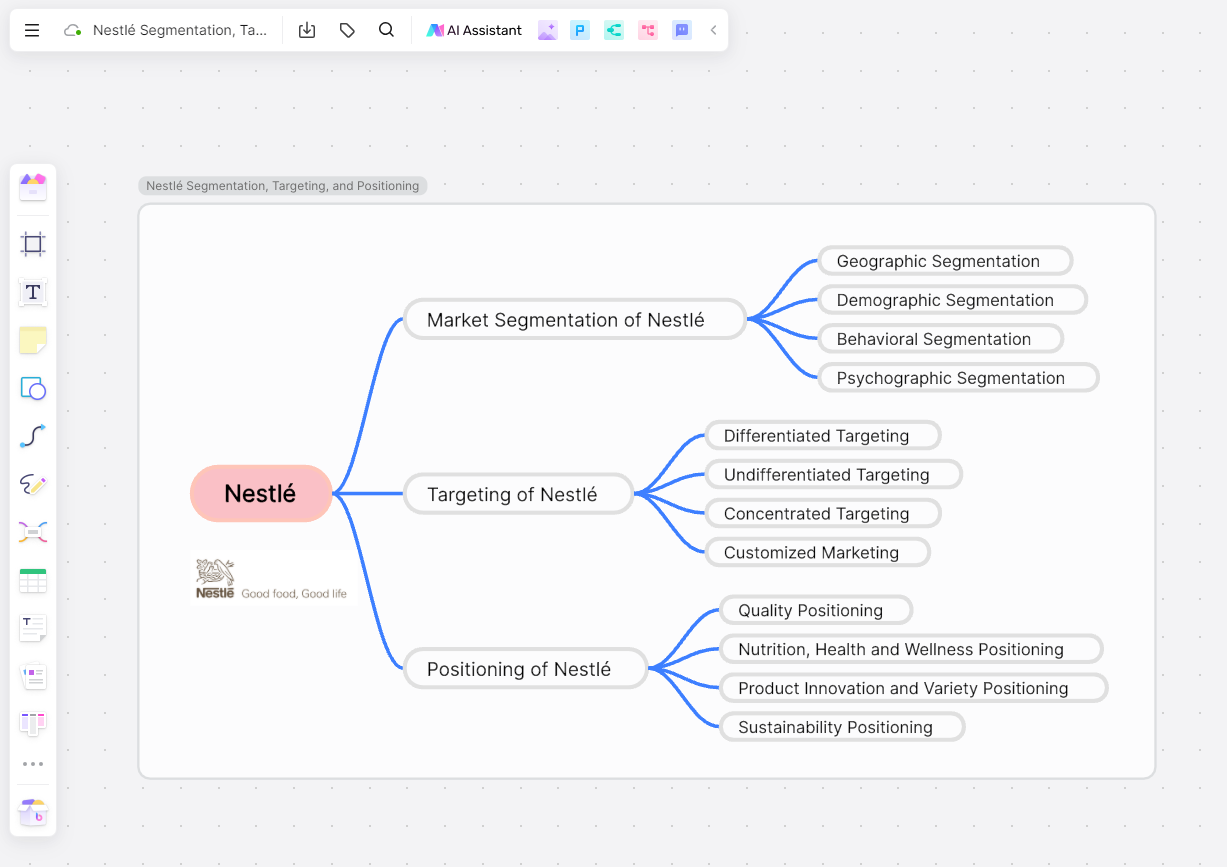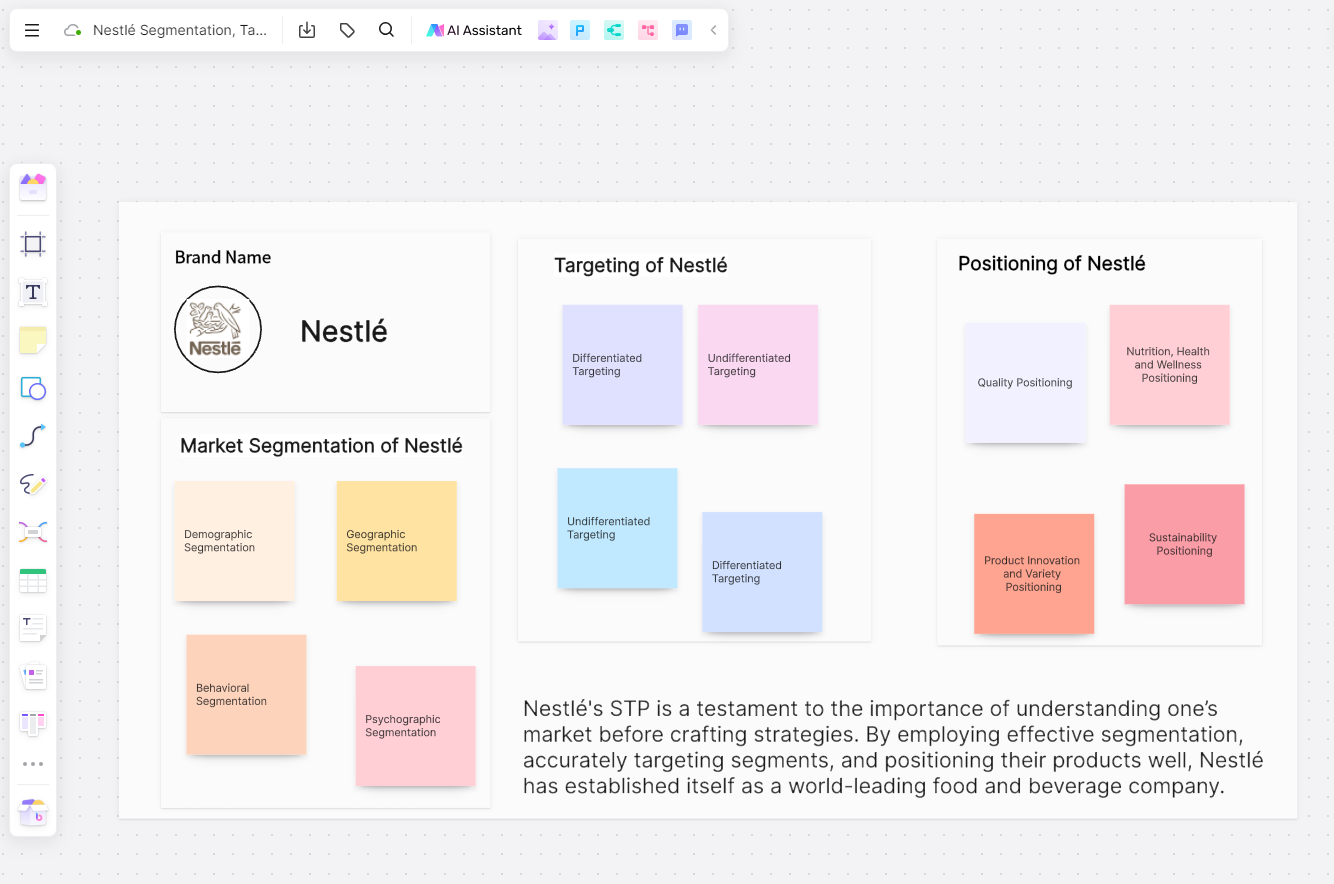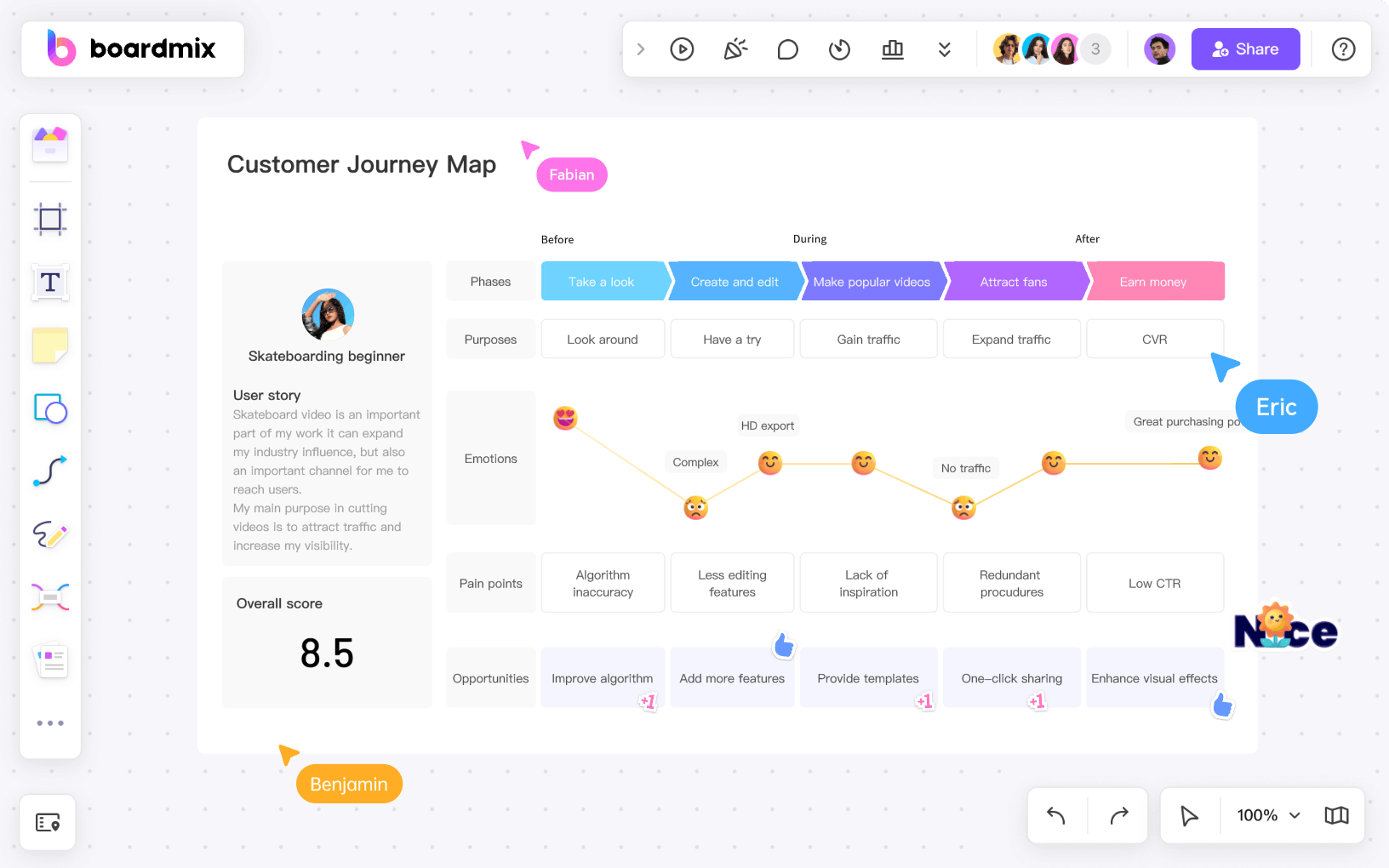Weaving a robust corporate strategy involves an understanding of the market you're operating in, and it begins with segmentation, targeting, and positioning (STP). Nestlé, a multinational food and drink corporation, has aptly used this strategy to their advantage. This detailed dissection of Nestlé's segmentation, targeting, and positioning strategies provides a valuable peek into the company's methods.
Nestlé Segmentation, Targeting, and Positioning Mind Map
To comprehend the strategic decisions that shape a conglomerate like Nestlé, it's crucial to break them down into digestible fragments. Hence, we will present you with a clear Nestlé Segmentation, Targeting, and Positioning mind map that succinctly illustrates how the company navigates its diverse market segments. This mind map will deliver a concise overview of the distinct components of Nestlé’s strategy, paving your way to valuable insights.

Market Segmentation of Nestlé
Segmentation is the process of dividing a broad consumer or business market into sub-groups of consumers or segments based on some type of shared characteristics. With its finger firmly on the pulse of consumers worldwide, Nestlé's segmentation strategy underpins their global marketing prowess. This process helps them deliver products with high value to their customers.
Geographic Segmentation
Nestlé's reach spans the entire globe. The company operates in almost 200 countries, signifying a comprehensive and flexible geographic segmentation strategy. They not only cater to metropolitan cities, bustling towns, and tranquil villages but also adapt their products to accommodate regional tastes and preferences. For instance, the company introduces spices into their Maggi noodles to satiate the Indian market's spice-loving palate.
Demographic Segmentation
In terms of demographic segmentation, Nestlé caters to almost every conceivable age group. Starting with Gerber, they nourish infants, while their Nesquik brand is targeted towards kids and teenagers. Nescafé coffee is a preferred choice among adults worldwide. With Boost and other similar products, they cater to the health and nutrition needs of seniors.
Income also forms a significant demographic factor for Nestlé. They ensure that a portion of their product portfolio is pocket-friendly to serve the low and middle-income group while also offering premium products for consumers in the high-income bracket.
Behavioral Segmentation
On understanding the behavioral patterns and consumption habits of its customers, Nestlé offers products catering to various occasions, benefits sought, and usage rate. It segments markets based on consumer knowledge, attitude, use or response to a product.
From providing everyday consumables such as dairy products and beverages to occasion-specific items like chocolates and confectioneries, they cover a broad spectrum of behavioral aspects.
Psychographic Segmentation
Psychographic segmentation forms another vital cog in Nestlé's market segmentation wheel. By considering lifestyle preferences, personality traits, values, attitudes, interests, and other psychological criteria, Nestlé introduces products that resonate well with the emotional requirements of their consumers.
Targeting of Nestlé
Targeting is the second phase of the STP process, where businesses focus on those segments identified during the segmentation stage that are most attractive for their products or services. Nestlé's targeted marketing exhibits a well-crafted blend of understanding their consumer needs and strategically directing their products towards those specific segments.
Differentiated Targeting
Following a differentiated targeting strategy, Nestlé pursues multiple market segments, each with a uniquely tailored marketing mix. They serve a wide range of customer segments by offering a diversified product portfolio.
For instance, with their 'Gerber' baby food line, they are specifically targeting health-conscious parents who want nutritious food for their infants. Nestlé’s ‘Boost’ range is specifically tailored for the aging population, targeting the senior demographic with a high-protein drink that caters to their unique nutritional requirements.
Undifferentiated Targeting
While Nestlé follows differentiated targeting predominantly, they also resort to undifferentiated targeting or mass marketing for certain products. Nestlé Pure Life water is a clear example where Nestlé targets the whole market without segment differentiation, considering the universal need for pure and safe drinking water.
Concentrated Targeting
In some cases, Nestlé also adopts concentrated targeting. This approach entails tailoring marketing efforts to one particular segment. For instance, with their high-end San Pellegrino sparkling water, they are targeting the premium segment of customers who are willing to pay more for gourmet products.
Customized Marketing
Nestlé is not new to experimenting with customized marketing as well. The introduction of Nespresso machines and their range of capsules allowed the company to offer personalized coffee experiences for their customers.
Nestlé's targeting strategy extends beyond standard practices, providing a comprehensive range of products to an array of different target groups. Their ability to identify and accurately target their market segments has played an integral role in making them one of the world's leading food and beverage companies.
Positioning of Nestlé
Positioning is the final phase in the Segmentation Targeting Positioning Cycle. Once a company has segmented its market and defined its target, the next step is to position its products or services in the minds of the consumers. Nestlé, by creating a unique, clear, and advantageous position in the consumer's mind, has successfully positioned itself as a global leader in the food and beverage industry.
Quality Positioning
Quality is one of the significant attributes that consumers associate with Nestlé. From using high-quality ingredients to adhering to stringent manufacturing standards, Nestlé's commitment to quality reverberates through its extensive product range. This commitment has paid off as consumers around the world see Nestlé as a brand they can trust for quality and reliability.
Nutrition, Health and Wellness Positioning
Nestlé positions itself as a Nutrition, Health and Wellness company. They are committed to enhancing lives with science-based nutrition and health solutions for all stages of life. This positioning aligns perfectly with their mission of 'Good Food, Good Life' and resonates well with their health-conscious consumers.
Product Innovation and Variety Positioning
Nestlé continuously strives to innovate and improve their product range to cater to the evolving needs of its customers, which is a significant part of its positioning strategy. The company's drive to experiment and provide something new enables them to cater to various customer segments effectively. From plant-based meat alternatives to dairy-free ice cream, their innovative spirit keeps them ahead in the competition.
Sustainability Positioning
With an increased global focus on sustainability, Nestlé positions itself as a socially responsible corporation. They aim to make 100% of their packaging recyclable or reusable by 2025. This sustainability positioning not only gives them an edge in a competitive market but also helps build trust among eco-conscious consumers.
Nestlé's positioning strategy aims to keep them at the top of consumers' minds when it comes to quality, nutrition, health, wellness, innovation, variety, and sustainability. By focusing on these elements, they manage to maintain their position as one of the world’s leading food and beverage companies.
Nestlé Segmentation, Targeting, and Positioning Cheat Sheet
To encapsulate this wealth of information into a simple resource, we provide a Nestlé Segmentation, Targeting and Positioning cheat sheet. This tool will concisely lay out the discussed insights for quick reference or review. Its primary purpose is to help you distill complex strategies into easily digestible pieces.

Key Takeaways: Making Brand Positioning Analysis on Boardmix
Nestlé's STP is a testament to the importance of understanding one’s market before crafting strategies. By employing effective segmentation, accurately targeting segments, and positioning its products well, Nestlé has established itself as a world-leading food and beverage company.
To emulate this success in your own business strategy, consider using Boardmix, a powerful tool designed to aid in strategic planning. To further streamline the process, leverage our pre-built Market Segmentation Template and STP Analysis Template, which can be customized to fit your specific needs.
Understanding your brand's unique position in the market can give your business a competitive edge. Boardmix is an excellent tool for conducting a brand positioning analysis, providing various benefits.

1. Structured Analysis
With Boardmix, you can use or create custom templates for your brand positioning analysis. These templates can guide you through the process, ensuring that all vital factors - such as Unique Selling Proposition (USP), target audience, brand values, brand personality, and key differentiators - are thoroughly addressed.
2. Collaboration
Brand positioning analysis often requires insights from various team members - from marketing to product development. Boardmix's collaboration features make it easy to involve your entire team in the process, facilitating an exchange of ideas and perspectives that can enrich your analysis.
3. Accessibility
With Boardmix, your brand positioning analysis is not just a static document. It's a dynamic resource that's accessible to your team members anytime, anywhere. This makes it easier to keep everyone aligned on your brand's positioning and strategic direction.
4. Iterative Refinement
The market is constantly evolving, and so should your brand positioning. Boardmix makes it easy to update your analysis as your brand grows and the market changes. You can easily add new insights, adjust your strategies, and keep your team informed about these changes.
5. Integrated Feedback
The platform allows stakeholders to provide their feedback directly on the analysis. This integrated feedback system streamlines communication and makes it easier to refine your brand positioning based on valuable input.
6. Historical Reference
Your previous brand positioning analyses on Boardmix can serve as valuable historical references. Comparing your current positioning with past strategies can offer insights into how your brand has evolved.
By facilitating collaboration, structuring analysis, and offering flexibility, Boardmix is a beneficial tool for any company looking to deepen its understanding of its brand positioning.








